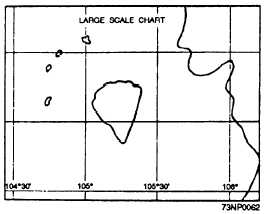distance on a Mercator chart, one must be careful to
use the latitude scale at the proper place.
Distance is measured by placing one end of the
dividers at each end of the line to be measured and,
without changing the setting of the dividers,
transferring them to the latitude scale with the middle
of the dividers at about the middle latitude of the two
points between which the distance is desired.
TYPES OF CHARTS
Of the types of charts used today, Mercator
projection charts are the most commonly used
navigational charts. Other charts used include the
transverse Mercator, polyconic, and gnomonic
projections. For more information on the use of these
charts, consult Dutton‘s Navigation and Piloting or the
American Practical Navigator, Pub. No. 9.
CHART SCALES
The scale of a chart refers to a measurement of
distance-not area. A chart covering a relatively large
area is called a small-scale chart, and one covering a
relatively small area is called a large-scale chart.
Scales may vary from 1:1,200 for plans to
1:14,000,000 for world charts. Normally, the major
types of charts fall within the following scales:
Harbor and Approach Charts—Scales larger than
1:50,000. These charts are used in harbors, anchorage
areas, and the smaller waterways. Those charts used for
approaching more confined waters are called approach
charts.
Coastal Charts—1:50,000 to 1:150,000. These
charts are used for inshore navigation, for entering bays
and harbors of considerable width, and for navigating
large inland waterways.
General and Sailing Charts—l:150,000 or
smaller. These charts are used for coastal navigation
outside outlying reefs and shoals when the vessel is
generally within sight of land or aids to navigation and
its course can be directed by piloting techniques. They
are also used in fixing the position as the ship
approaches the coast from the open ocean and for
sailing between distant coastal ports.
The size of the area portrayed by a chart varies
extensively according to the scale of the chart. The
larger the scale, the smaller the area it represents. It
follows then that large-scale charts show areas in
greater detail (fig. 9-6.) Many features that appear on
Figure 9-6.—Comparison of small- and large-scale charts.
a large-scale chart do not show up on a small-scale
chart of the same area.
The scale to which a chart is drawn usually
appears under its title in one of two ways: 1:25,000
or l/25,000. These figures mean that an actual feature
is 25,000 times larger than its representation on the
chart. Expressed another way, an inch, foot, yard, or
any other unit on the charts means 25,000 inches, feet,
or yards on Earth's surface. Thus, the larger the figure
indicating the proportion of the scale, the smaller the
scale of the chart. A chart with a scale of 125,000 is
on a much larger scale, for instance, than one whose
scale is 1:4,500,000.
You must exercise more caution when working
with small-scale charts than with large-scale charts. A
small error, which may be only a matter of yards on a
large-scale chart, could amount to miles on a chart
depicting a much more extensive area. When
navigating the approaches to land, use the largest scale
charts available.
9-5




